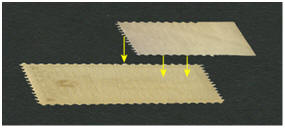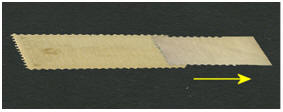How To Replace
Lost Gum
By Bill Weiss
Cautionary note: Restoring or altering gum can affect the value of your stamp(s). Many
collectors would rather have a stamp in its existing condition than have one
in which has had modifications. Some collectors feel doing minor
restorations to their stamps is acceptable and restoring gum is within
acceptable limits; others do not. No matter how you feel about the
restoration of stamps one thing remains the same; if you make any
restorations to a stamp you should document them and offer full disclosure
to any future buyers of that stamp.
Note that most of the time gum restoration is easy
to detect by others, but it can be relatively difficult to detect in some
cases. This depends on the extent of the work and the skill of the person
doing the work. It can be misrepresented by some sellers (who may, for
example, try to sell a stamp which has smoothed-over gum as NH, thus raising
the price and deceiving the buyer), so expert advice is recommended if you
are in doubt about the correct status of the gum).
This article will explain how to replace lost gum by
transferring gum from one stamp to another. Gummed selvedge is also ideal
for this, and stamp hinges can also be used.

Simply apply moisture to the stamp or selvedge that has the full original gum. Be careful not to overdo the moisture. One good “lick” is about right as you are simply trying to soften up the gum enough that it will transfer easily to the one where it is missing.

Take the moistened stamp and lay it gum-side down onto the other copy, applying slight downward pressure

Allow it to sit for just a second or two. Then carefully but quickly slide the top stamp/selvedge off the other stamp, hopefully transferring the gum from the top to the bottom stamp.
This is a tricky procedure and care is highly recommended. I suggest
practicing with two cheap stamps, or one cheap stamp and one piece of
selvedge before attempting on a good stamp.
Sometimes multiple transfers must be done in order to get sufficient gum
onto the lost-gum stamp. After enough gum is transferred, the area can be
carefully smoothed over to give a nice appearance.
This gum transfer is not considered an alteration but rather an acceptable
restoration by most folks, although some may not agree.
Always remember that alterations are not acceptable in our hobby but there
is nothing inherently wrong with restoration work – so long as the
restoration(s) are disclosed. Unfortunately, quite often they are not, which
is what causes the problems with costly deceptions. Also understand that
these are only my opinions and others may disagree, which, of course, is
their right.





